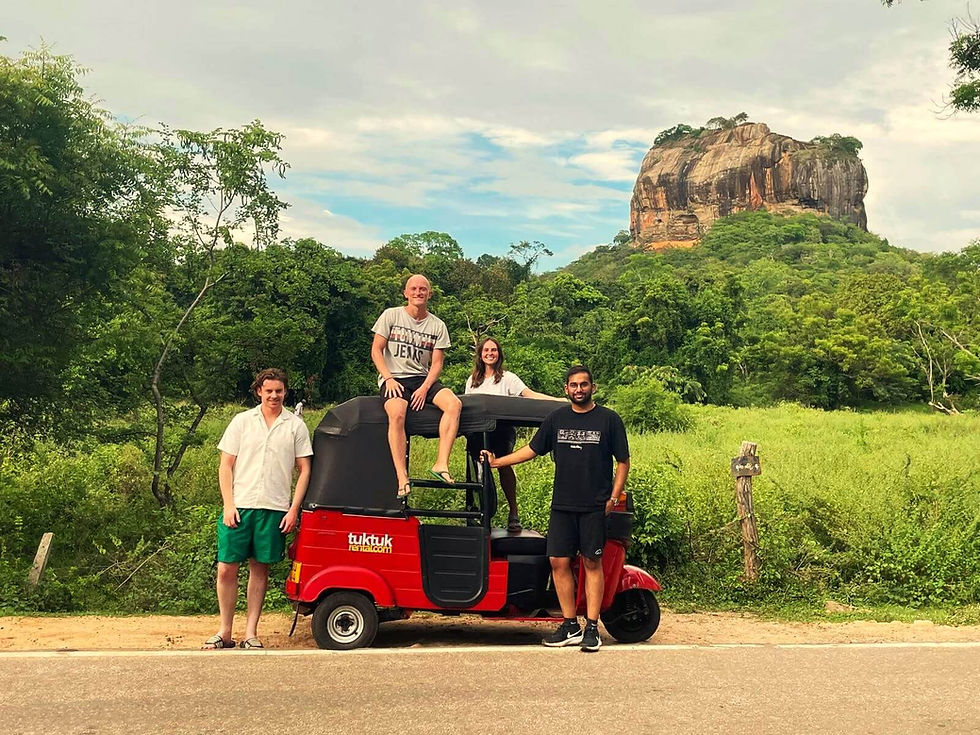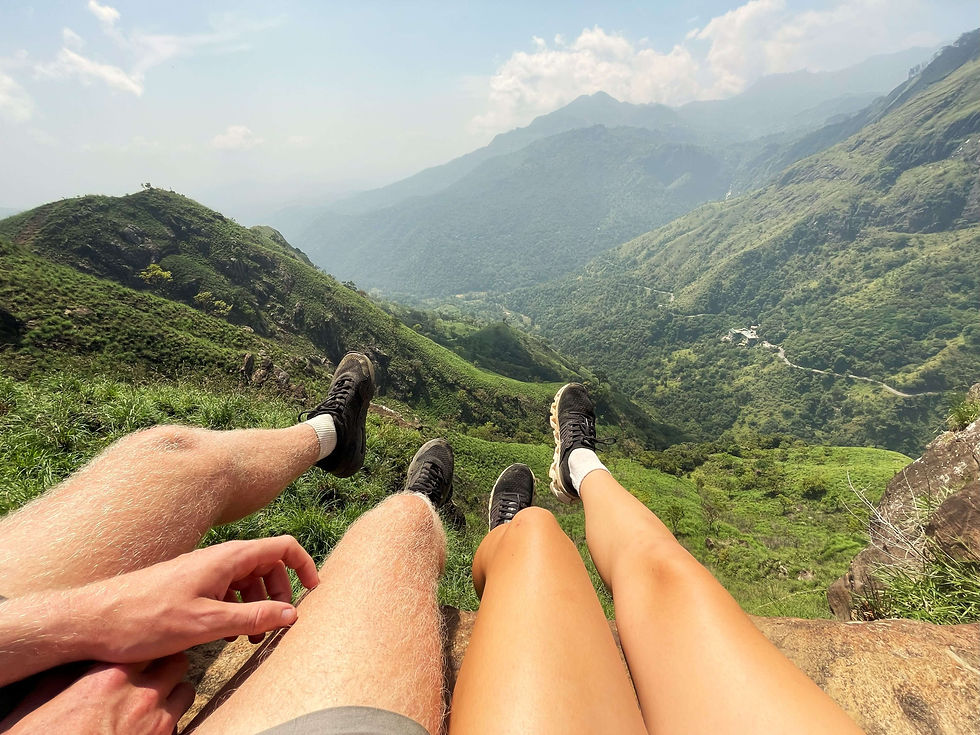Sri Lanka’s Two Monsoons Explained: Best Time to Visit for Surf, Safaris & Sun
- Kate Colliety

- Sep 22
- 6 min read
Sri Lanka is one of those rare places you can visit year-round. Thanks to its two monsoons, the sun is always shining somewhere on the island. Despite its small size, the landscape is varied, from mountain peaks to scrub forest and immaculate coastlines perfect for surfing.
The best time to visit Sri Lanka depends on your plans - whether you want to laze around the south coastal towns, road trip the entire country or travel to places just appearing on the tourist radar.
Below we share what to expect from Sri Lanka’s weather patterns month by month, what to expect in each region and when you should book your trip to Sri Lanka for the best experience.

When Is The Best Time To Visit Sri Lanka?
In short, the peak season runs from November to April. But here’s the catch: this is only the prime time for the south and west coasts. It’s actually monsoon season in the east, where you’ll find incredible spots like Trincomalee and Arugam Bay.
December to April is also the busiest time on the island, meaning towns like Hikkaduwa and Mirissa are crowded and accommodation gets booked up well in advance.
To avoid the crowds we recommend visiting in October, November or May. You might get the occasional downpour but you will also get moments where you get the beach completely to yourself! We visited from October to December and managed to visit both the west and east of the island without too much rain!
Sri Lanka’s Climate Geography Overview
Sri Lanka’s varied landscapes create a surprising number of microclimates. Thanks to its position near the equator, daytime temperatures hover around 30°C year-round.
This comes with a slight caveat: if you head into the mountains to towns such as Nuwara Eliya and Ella temperatures can drop to as little as 10°C at night, so make sure to pack your fleece!
The key thing to consider when planning your trip to Sri Lanka is the two monsoon seasons Sri Lanka experiences. The country is basically split diagonally down the middle, creating two halves.
The east and north experience the northeast monsoon from May to October (Maha Monsoon).
The south and west get the southwest monsoon from November to April.
This can be frustrating if you want to see the whole country as somewhere is always going to be rainy but on the other hand the great news is that somewhere is going to be sunny! We decided to roadtrip the country, heading west in October to catch the end of the dry season, then headed to the south coast in November for the start of the peak season. This nearly went to plan except we got caught in a typhoon when we were in Nuwara Eliya, Little England living up to its name!
Map Of Sri Lanka’s Monsoon Seasons
Sri Lanka’s monsoon seasons can be a bit confusing, so we’ve created a simple map to help you understand how the two monsoons affect different parts of the island.

When To Visit Sri Lanka Month By Month
December To March: Peak Season For The South Coast
This is peak season in Sri Lanka, when the sun shines on the popular south coast, home to hotspots like Galle, Hikkaduwa, Weligama, Mirissa and Tangalle. It is also the peak surf season, which sees beginner surfers flock to Weligama to learn and more advanced surfers hitting up the reefs in Midigama.
The island is busy, hotel prices rise and you have a high chance of spotting leopards in Yala National Park due to animals gathering around the watering holes.
It is also the time of the northwest monsoon, meaning the ancient city of Anuradhapura and the up and coming tourist destination of Trincomalee are experiencing wet, muggy temperatures.
December is the pilgrimage season on Adam’s Peak. If you plan to hike the 5,500 steps expect queues at the top!

May To August: Peak Season For The East Coast
Although May to August is technically the low season in Sri Lanka with the south coast and hill country experiencing the Yala monsoon, there are still great off-the-beaten-track areas to visit. Head north to Jaffna, which has more of an Indian influence, or east to Trincomalee, where May is also the start of the whale watching season, or to Arugam Bay, which is one of our favourite towns in Sri Lanka famous for its surf culture.
In July and August, Esala Perahera occurs in Kandy. A procession of thousands of dancers and drummers make their way through the city.

September, October & April: The Shoulder Seasons
As budget backpackers, we love a shoulder season, fewer people and cheaper prices, what’s not to like! Sri Lanka spoils us with two shoulder seasons: September and October and April
There are still dry pockets in Sri Lanka, thanks to the microclimates and it’s a great time to head to Sigiriya, which experiences cooler temperatures compared to the height of summer. In October we caught the end of the surf season in Arugam Bay, we had good waves everyday and only the occasional thunderstorm that passed quickly.
In September the annual gathering of elephants occurs in Minneriya National Park, plus you’ll have a high chance of seeing baby elephants.
Regional Weather Differences in Sri Lanka
Sri Lanka’s weather isn’t just split between east and west, it also changes dramatically based on elevation and geography. Here’s what to expect in different regions:
Hill Country (e.g. Nuwara Eliya, Ella, Adam’s Peak)
Cooler year-round, especially at night - pack layers!
Expect misty mornings, rain showers, and temps that can drop to 10°C
Best time to visit: January to April for clearer skies

Dry Zone (e.g. Sigiriya, Anuradhapura, Dambulla, Wilpattu)
Experiences less rain year-round due to geographic location
Hot and dry much of the year, with short bursts of rain
Great for cultural sites and national parks (elephant spotting!)

South & West Coast (e.g. Galle, Mirissa, Weligama)
Best from December to April with average temperatures of 27°C
Southwest monsoon hits May to August - expect rougher seas and rain plus lots of business shut

East & North (e.g. Trincomalee, Arugam Bay, Jaffna)
Best from May to September
Monsoon affects this area from October to January
Whale watching in Trincomalee from May to September
Our Experience Travelling Sri Lanka
We spent 8 weeks exploring Sri Lanka in our trusty red tuk tuk. We arrived in October and headed straight up north to Anuradhapura and Wilpattu to catch the tail end of the dry season.
From there, we drove to Trincomalee, although we’d sadly missed the whale season, then continued down to Arugam Bay where we caught the last waves of the season.
Our plan was to chase the sun, so we headed down the south coast in November for surfing in Weligama and lazy beach days.
Of course, it can’t all go to plan, when we headed to the mountains, Nuwara Eliya, the Knuckles Range and Ella we did catch the start of the monsoon weather. But despite a few downpours (and a couple of water-damaged phones!), we still had an epic time exploring the hill country.

Final Thoughts On The Best Time To Visit Sri Lanka
Overall it comes down to preference of how you like to travel! If you don’t like the crowds and don’t mind an odd rainstorm then we’d recommend visiting in October and November.
For surfing Weligama has the best waves from December to March and Arugam Bay’s season runs from April to October, meaning there is always somewhere to surf in Sri Lanka.
The peak season for the south coast is December to April, but it does get super busy!
Surfing Accessories Sri Lanka is a surfers paradise and it's also great for beginners with multiple surf spots being a sandy bottom. Don't forget a zinc sun cream and surf hat!
| |
LifeStraw Filtered Water Bottle Allowing you to fill up water whenever and wherever with peace of mind plus you’re helping the environment! | |
Binoculars For SafariHome to leopards, elephants and crocodiles having a pair of binoculars is a must to appreciate the wildlife Sri Lanka has to offer! | |
Top Tips For Travelling Sri Lanka
Rent a Tuk Tuk as Transport - This made our trip! Not only did we have complete freedom and flexibility it allowed us to have authentic relationships with locals. Use our code "KandM" for 5% off Tuktuk Rental
Stay in Homestays - Staying in local homestays meant we experienced authentic food and the local way of life. Everyone was extremely friendly and happy to help.
Don’t Forget the North - Many tourists stick to the south coast but if you have time explore places such as Anuradhapura, Trincomalee and Arugam bay!
Embrace The Chaos and get stuck in, the locals are friendly and love to help and share information about their home!

Travel Tools To Help You Plan
These are some of the travel tools we love and use daily, by booking through our links you support our blog and help us grow, thank you.
Thank you for reading and enjoy your Sri Lankan adventure. Reach out to us over on Instagram @KateandMikesTravels. We always love to hear from people who read our blogs!









.png)

Comments